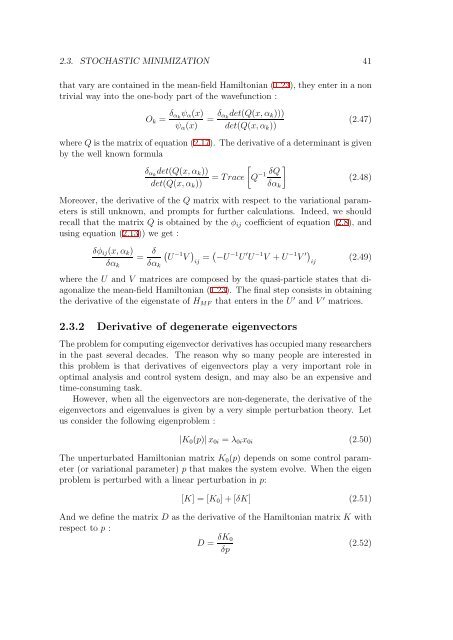pdf, 9 MiB - Infoscience - EPFL
pdf, 9 MiB - Infoscience - EPFL
pdf, 9 MiB - Infoscience - EPFL
Create successful ePaper yourself
Turn your PDF publications into a flip-book with our unique Google optimized e-Paper software.
2.3. STOCHASTIC MINIMIZATION 41<br />
that vary are contained in the mean-field Hamiltonian (1.23), they enter in a non<br />
trivial way into the one-body part of the wavefunction :<br />
O k = δ α k<br />
ψ α (x)<br />
ψ α (x)<br />
= δ α k<br />
det(Q(x, α k )))<br />
det(Q(x, α k ))<br />
(2.47)<br />
where Q is the matrix of equation (2.17). The derivative of a determinant is given<br />
by the well known formula<br />
[ ]<br />
δ αk det(Q(x, α k ))<br />
−1<br />
δQ<br />
= Trace Q (2.48)<br />
det(Q(x, α k ))<br />
δα k<br />
Moreover, the derivative of the Q matrix with respect to the variational parameters<br />
is still unknown, and prompts for further calculations. Indeed, we should<br />
recall that the matrix Q is obtained by the φ ij coefficient of equation (2.8), and<br />
using equation (2.13)) we get :<br />
δφ ij (x, α k )<br />
= δ (<br />
U −1 V ) δα k δα = ( −U −1 U ′ U −1 V + U −1 V ′) (2.49)<br />
ij ij k<br />
where the U and V matrices are composed by the quasi-particle states that diagonalize<br />
the mean-field Hamiltonian (1.23). The final step consists in obtaining<br />
the derivative of the eigenstate of H MF that enters in the U ′ and V ′ matrices.<br />
2.3.2 Derivative of degenerate eigenvectors<br />
The problem for computing eigenvector derivatives has occupied many researchers<br />
in the past several decades. The reason why so many people are interested in<br />
this problem is that derivatives of eigenvectors play a very important role in<br />
optimal analysis and control system design, and may also be an expensive and<br />
time-consuming task.<br />
However, when all the eigenvectors are non-degenerate, the derivative of the<br />
eigenvectors and eigenvalues is given by a very simple perturbation theory. Let<br />
us consider the following eigenproblem :<br />
|K 0 (p)| x 0i = λ 0i x 0i (2.50)<br />
The unperturbated Hamiltonian matrix K 0 (p) depends on some control parameter<br />
(or variational parameter) p that makes the system evolve. When the eigen<br />
problem is perturbed with a linear perturbation in p:<br />
[K] =[K 0 ]+[δK] (2.51)<br />
And we define the matrix D as the derivative of the Hamiltonian matrix K with<br />
respect to p :<br />
D = δK 0<br />
(2.52)<br />
δp
















